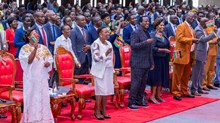For one church in Seabrook, Texas — just north of Galveston, on the bay — the damage from Hurricane Ike is a blessing in disguise.
Tony McCollum, pastor of the 900-member Seabrook United Methodist Church, said the September 13 hurricane's damage will benefit the church, at least in one way. The church will use the insurance money to get a head start on a long-planned new sanctuary. McCollum hopes the insurance money will cover the $3 million first phase of the project. The church's current buildings — the highest of which was flooded with three feet of water — will all be torn down.
"We've been working on this move for 12 years," said McCollum. "Now we're going to be able to let go and say, you know what, at this point we have no option."
This Sunday, the congregation had an outdoor worship service at the site of the new building. McCollum is not sure what the congregation will do until the new building is built, but is considering a modular building, sharing space with another church, or meeting in storefront property.
But as McCollum and other church leaders begin cleaning up the damage from Hurricane Ike, they are concerned about the storm's less visible effects.
After hurricanes Rita and Katrina in 2005, McCollum said, Seabrook United Methodist lost about 20 families who were tired of frequently preparing for storms and moved. The pastor is now bracing for another wave of departures.
"We had a lot of folks who just got weary battling the hurricane," he said. "A consultant called it the Rita effect: we had a lot of members move away from the community because they just got tired of battling nature."
Another problem churches are preparing to face is less giving, as families use their money to rebuild their homes and lives. The budget at Seabrook United Methodist will shrink, McCollum said, but he's not yet sure where or how.
On Galveston Island, 25 miles south of Seabrook, some churches may be shutting down altogether because of the hurricane.
Sharon Burns, pastor of two Lutheran churches on Galveston, said one of her churches (Saint Paul's) will likely shut down permanently because of Ike, and services at the other (Zion Lutheran) won't resume for two or three months. The island itself won't be open for residents to move back for at least a month, said Sara Martin, administrative assistant to Galveston County judge James D. Yarbrough.
The 27-by-3-mile island is home to more than 100 churches, Burns said.
Burns has not been to the island since the hurricane hit, but a member of Zion Lutheran drove by the building and reported it had three feet of flooding. Burns hasn't heard an update on the other church and is still trying to contact the members.
Galveston is no stranger to hurricanes and floods; the largest and most famous hit in 1900 and killed an estimated 8,000 people. In spite of disasters, though, most residents don't want to leave.
"Their history goes back — parents and grandparents and the stories of what they put up with," Burns said. "We have people who can talk about people who knew people in the 1900 flood. I'm not from Texas, so I'm going, 'I'd move!' but that's not the attitude on the island. It's their home."
Further inland, Houston Baptist University is also facing setbacks from the hurricane. A campus-wide power outage forced a break from classes, and flooding destroyed several administrative buildings in the center of campus, said Hunter Baker, special assistant to HBU's president.
Damage is estimated at $10 million to $12 million, Baker said, where it has climbed from the initial estimate of $5 million. Classroom space wasn't damaged so officials and classes resumed Monday as power returned. Administrators had been working out of the president's home and are now scattered across the campus.
"Our hope is this will be more of a problem for the administration than the students or professors," Baker said.
Churches in Houston are also recovering from power outages and flooding while struggling to provide help to congregation and community members.
In an odd role reversal from Hurricane Katrina relief programs in 2005, staff members at First Presbyterian Church in Houston have been getting concerned text messages and phone calls from New Orleans residents who had been evacuated to Houston in the wake of Katrina.
"The whole thing has been surreal," said Mary Floye Federer, director of global missions at First Presbyterian Church in Houston. The church building wasn't damaged, but power has been out and staff members are scattered across the city.
"Not realizing until I look in the newspaper — that's finally started back — and seeing horrific pictures in Bolivar, in Galveston, and even in the third ward and fifth ward where people are getting MREs, you're like, 'Oh my gosh, that's us — that's home."
Copyright © 2008 Christianity Today. Click for reprint information.
Related Elsewhere:
See also the Houston Chronicle's article, "Ike damages houses of worship, but not believers' faith" and "Churches meet and pray for strength on Island" from the Galveston Daily News.

Support Our Work
Subscribe to CT for less than $4.25/month


















